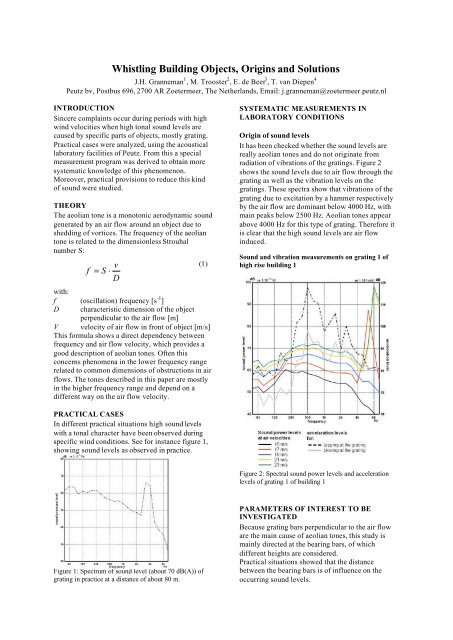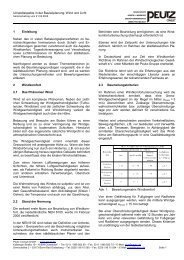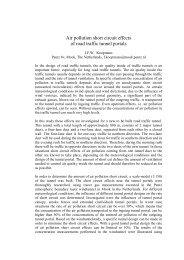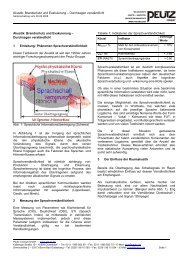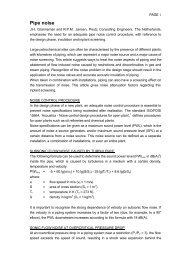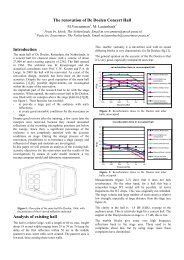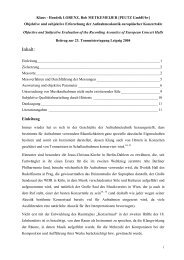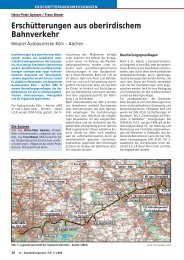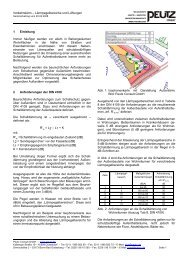Whistling Building Objects, Origins and Solutions - Peutz.co.uk
Whistling Building Objects, Origins and Solutions - Peutz.co.uk
Whistling Building Objects, Origins and Solutions - Peutz.co.uk
You also want an ePaper? Increase the reach of your titles
YUMPU automatically turns print PDFs into web optimized ePapers that Google loves.
<strong>Whistling</strong> <strong>Building</strong> <strong>Objects</strong>, <strong>Origins</strong> <strong>and</strong> <strong>Solutions</strong><br />
J.H. Granneman 1 , M. Trooster 2 , E. de Beer 3 , T. van Diepen 4<br />
<strong>Peutz</strong> bv, Postbus 696, 2700 AR Zoetermeer, The Netherl<strong>and</strong>s, Email: j.granneman@zoetermeer.peutz.nl<br />
INTRODUCTION<br />
Sincere <strong>co</strong>mplaints occur during periods with high<br />
wind velocities when high tonal sound levels are<br />
caused by specific parts of objects, mostly grating.<br />
Practical cases were analyzed, using the a<strong>co</strong>ustical<br />
laboratory facilities of <strong>Peutz</strong>. From this a special<br />
measurement program was derived to obtain more<br />
systematic knowledge of this phenomenon.<br />
Moreover, practical provisions to reduce this kind<br />
of sound were studied.<br />
THEORY<br />
The aeolian tone is a monotonic aerodynamic sound<br />
generated by an air flow around an object due to<br />
shedding of vortices. The frequency of the aeolian<br />
tone is related to the dimensionless Strouhal<br />
number S:<br />
f = S ⋅<br />
v<br />
D<br />
(1)<br />
with:<br />
f (oscillation) frequency [s -1 ]<br />
D characteristic dimension of the object<br />
perpendicular to the air flow [m]<br />
V velocity of air flow in front of object [m/s]<br />
This formula shows a direct dependency between<br />
frequency <strong>and</strong> air flow velocity, which provides a<br />
good description of aeolian tones. Often this<br />
<strong>co</strong>ncerns phenomena in the lower frequency range<br />
related to <strong>co</strong>mmon dimensions of obstructions in air<br />
flows. The tones described in this paper are mostly<br />
in the higher frequency range <strong>and</strong> depend on a<br />
different way on the air flow velocity.<br />
PRACTICAL CASES<br />
In different practical situations high sound levels<br />
with a tonal character have been observed during<br />
specific wind <strong>co</strong>nditions. See for instance figure 1,<br />
showing sound levels as observed in practice.<br />
Figure 1: Spectrum of sound level (about 70 dB(A)) of<br />
grating in practice at a distance of about 80 m.<br />
SYSTEMATIC MEASUREMENTS IN<br />
LABORATORY CONDITIONS<br />
Origin of sound levels<br />
It has been checked whether the sound levels are<br />
really aeolian tones <strong>and</strong> do not originate from<br />
radiation of vibrations of the gratings. Figure 2<br />
shows the sound levels due to air flow through the<br />
grating as well as the vibration levels on the<br />
gratings. These spectra show that vibrations of the<br />
grating due to excitation by a hammer respectively<br />
by the air flow are dominant below 4000 Hz, with<br />
main peaks below 2500 Hz. Aeolian tones appear<br />
above 4000 Hz for this type of grating. Therefore it<br />
is clear that the high sound levels are air flow<br />
induced.<br />
Sound <strong>and</strong> vibration measurements on grating 1 of<br />
high rise building 1<br />
Figure 2: Spectral sound power levels <strong>and</strong> acceleration<br />
levels of grating 1 of building 1<br />
PARAMETERS OF INTEREST TO BE<br />
INVESTIGATED<br />
Because grating bars perpendicular to the air flow<br />
are the main cause of aeolian tones, this study is<br />
mainly directed at the bearing bars, of which<br />
different heights are <strong>co</strong>nsidered.<br />
Practical situations showed that the distance<br />
between the bearing bars is of influence on the<br />
occurring sound levels.
Therefore a test grating was designed, of which the<br />
distances <strong>co</strong>uld be varied without changing other<br />
parameters. Based on <strong>co</strong>mmon practice a thickness<br />
of 2 mm for the (galvanized) steel of the bearing<br />
bars has been used.<br />
Sharp edges of the steel bearing bars have been<br />
used since practice showed that rounding the edges<br />
decreases the generated sound levels.<br />
MEASUREMENT SET UP<br />
In the a<strong>co</strong>ustical laboratory of <strong>Peutz</strong> in Mook<br />
“silent air” is available. For this specific research<br />
the velocity of the air flow was variable from 0 up<br />
to about 30 m/s.<br />
Figure 3 shows the test grating designed to<br />
determine the influence of height <strong>and</strong> distance<br />
between bearing bars, as well as the sharpness of<br />
the edges <strong>and</strong> the angle of attack of the air flow.<br />
The distance between bearing bars <strong>co</strong>uld be<br />
changed with intervals of 1 cm. The height of the<br />
studied bearing bars is 20, 30 en 40 mm. When at a<br />
certain air velocity an aeolian tone is observed for<br />
the first time, the angle of attack is changed in<br />
small steps.<br />
Figure 3: The test grating<br />
MEASUREMENT RESULTS<br />
In figure 4 measurement results regarding the test<br />
grating with bearing bars with a height of 40 mm<br />
<strong>and</strong> varying center to center (c.t.c.) spacing of<br />
bearing bars of respectively 30, 40, 50 en 60 mm<br />
are shown. The angle α of the air flow in this<br />
specific case is 26°, at which the aeolian tone is at<br />
its loudest. In the following only some<br />
representative results regarding this phenomena are<br />
presented.<br />
Figure 4a shows a clear peak at an air flow of 27<br />
m/s in the 3150 Hz third-octave b<strong>and</strong>. At an air<br />
flow velocity of 25 m/s two peaks are observed, in<br />
the 3150 <strong>and</strong> 10000 Hz third-octave b<strong>and</strong>s. These<br />
tones alternate in time, as can be seen from figure 5,<br />
showing the sound spectra as function of time.<br />
Figure 4a-d: Measurements on the test grating with a bar<br />
height of 40 mm.<br />
Figure 5: Spectral sound power levels as function of time<br />
for grating with bearing bars height / distance of 40 mm /<br />
30 mm at an air velocity of 25 m/s<br />
With air flow velocities below 20 m/s no tone is<br />
observed anymore. At c.t.c. spacing of respectively<br />
50 <strong>and</strong> 60 mm no tone at higher frequencies is<br />
observed; see figures 4c <strong>and</strong> 4d. This also applies to<br />
other angles of attack.<br />
Figure 6 deals with an angle α = 26°. Figure 6b<br />
gives the results with the grating tilted to 38°.<br />
Figure 6a shows a clear peak in the 3150 Hz thirdoctave<br />
b<strong>and</strong>, at air flows from 27 to 23 m/s with no<br />
significant change in sound level. At 22 m/s the<br />
tone disappears. At 16 m/s two tones are observed<br />
in the 3150 <strong>and</strong> 6300 Hz third-octave b<strong>and</strong>s with a<br />
relative low sound level.
At air flows lower than 16 m/s no tones occur.<br />
Changing the angle of attack to 38° the tone in the<br />
3150 Hz third-octave b<strong>and</strong> only remains at higher<br />
velocities.<br />
Angle of attack = 26 Angle of attack = 38<br />
Figure 6a-b: Measurements on the test grating with a bar<br />
height of 30 mm <strong>and</strong> a c.t.c. spacing of 40 mm for two<br />
different angles of attack.<br />
INFLUENCE OF THE AMOUNT OF BEARING<br />
BARS<br />
The dependency of the number of bearing bars was<br />
tested, starting with 1 bearing bar <strong>and</strong> subsequently<br />
adding an extra bearing bar in the test grating. Only<br />
with 9 bearing bars an aeolian tone was generated<br />
at the same frequency as with the <strong>co</strong>mplete grating<br />
(see figure 7) This clearly shows that the<br />
repetitiveness of the bearing bars of the grating is<br />
very important in generating this specific type of<br />
aeolean tones.<br />
Figure 7: Dependency of number of bearing bars<br />
SOUND REDUCING PROVISIONS<br />
Rounding the edge<br />
To determine the influence of rounding the edges of<br />
the bearing bars, tape was applied at the edges. See<br />
figure 8. It appeared that the treated bearing bars<br />
generate the loudest tone at a = 26° (see figure 8) at<br />
an air flow velocity of 27 m/s in the 3150 Hz thirdoctave<br />
b<strong>and</strong>.<br />
Figure 8: Bearing bars with tape-rounded edges<br />
Grating with sharp edges (untreated) Grating with tape-rounded edges<br />
Figure 9a-b: Measurements on the test grating with a bar<br />
height of 40 mm with sharp edges (a) <strong>and</strong> with taperounded<br />
edges (b).<br />
To see whether the same frequencies were<br />
involved, for both <strong>co</strong>nfigurations a FFT was made,<br />
see figure 9 (in both cases with an air flow velocity<br />
of 27 m/s).<br />
Grating with sharp edges (untreated)
Grating with tape-rounded edges<br />
Figure 10a-b: FFT of measurements on the test grating<br />
with untreated sharp edges (a) <strong>and</strong> with tape-rounded<br />
edges (b); air flow velocity of 27 m/s.<br />
Figure 10 shows that the frequencies remain the<br />
same in both <strong>co</strong>nfigurations, but the sound level is<br />
decreased with approximately 5 dB in the treated<br />
situation. No observable tones below 25 m/s are<br />
generated in the treated situation.<br />
Grating with net attachement<br />
Measurements regarding a grating with a net<br />
attached (see figure 11) show that this provision<br />
sufficiently reduces aeolian tones.<br />
Figure 11: Grating 1 of high rise building 1 treated with a<br />
net attached to the under side <strong>and</strong> the measurement<br />
results for different air flow velocities.<br />
CONCLUSIONS<br />
Aeolian tones at higher frequencies are generated at<br />
gratings with air flow velocities roughly above 10<br />
m/s (<strong>co</strong>mparable with 5 Beaufort <strong>and</strong> higher).<br />
Within a certain range of air flow velocities no<br />
change of generated frequency occurs. Only the<br />
sound levels change. At a certain air flow velocity<br />
this frequency jumps to another value, to remain<br />
<strong>co</strong>nstant again in a certain range of air flow<br />
velocities. In specific situations two frequencies are<br />
observed, however not simultaneously but<br />
alternating in time. The repetitiveness of the<br />
bearing bars of the grating is very important in<br />
generating this specific type of aeolian tones. This<br />
seems responsible for the sound generation in the<br />
higher frequencies, since no aeolian tones are<br />
observed when only a small number of bearing bars<br />
are set in the air flow.<br />
At all tested <strong>co</strong>nfigurations no high frequency<br />
aeolian tones are observed form a c.t.c. distance<br />
between the bearing bars of 50 mm <strong>and</strong> higher;<br />
only aeolian tones occur at lower frequencies<br />
related to the air flow velocity in <strong>co</strong>nformity with<br />
formula 1.<br />
Rounding the edges has led to a significant decrease<br />
of noise generation. Investigation with alternative<br />
types of gratings with less or different<br />
repetitiveness of bearing bars are planned.


